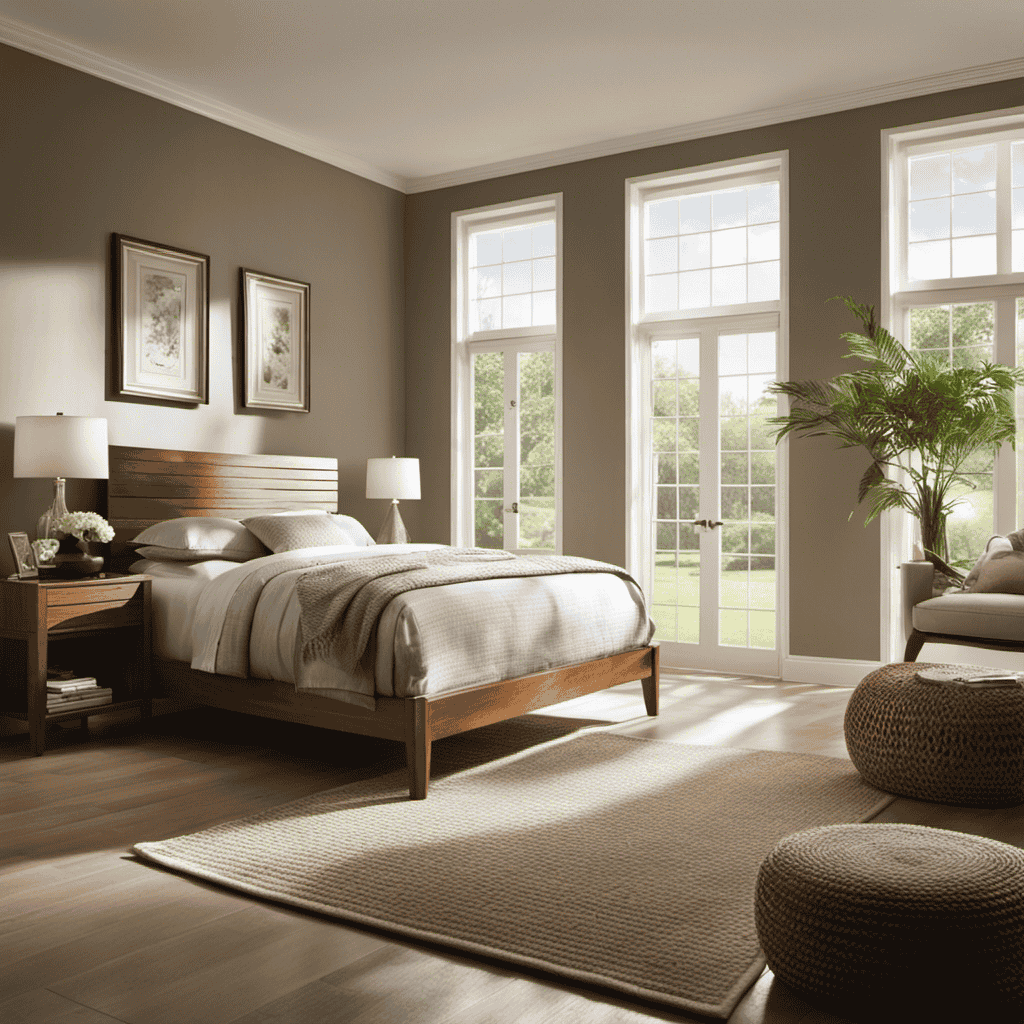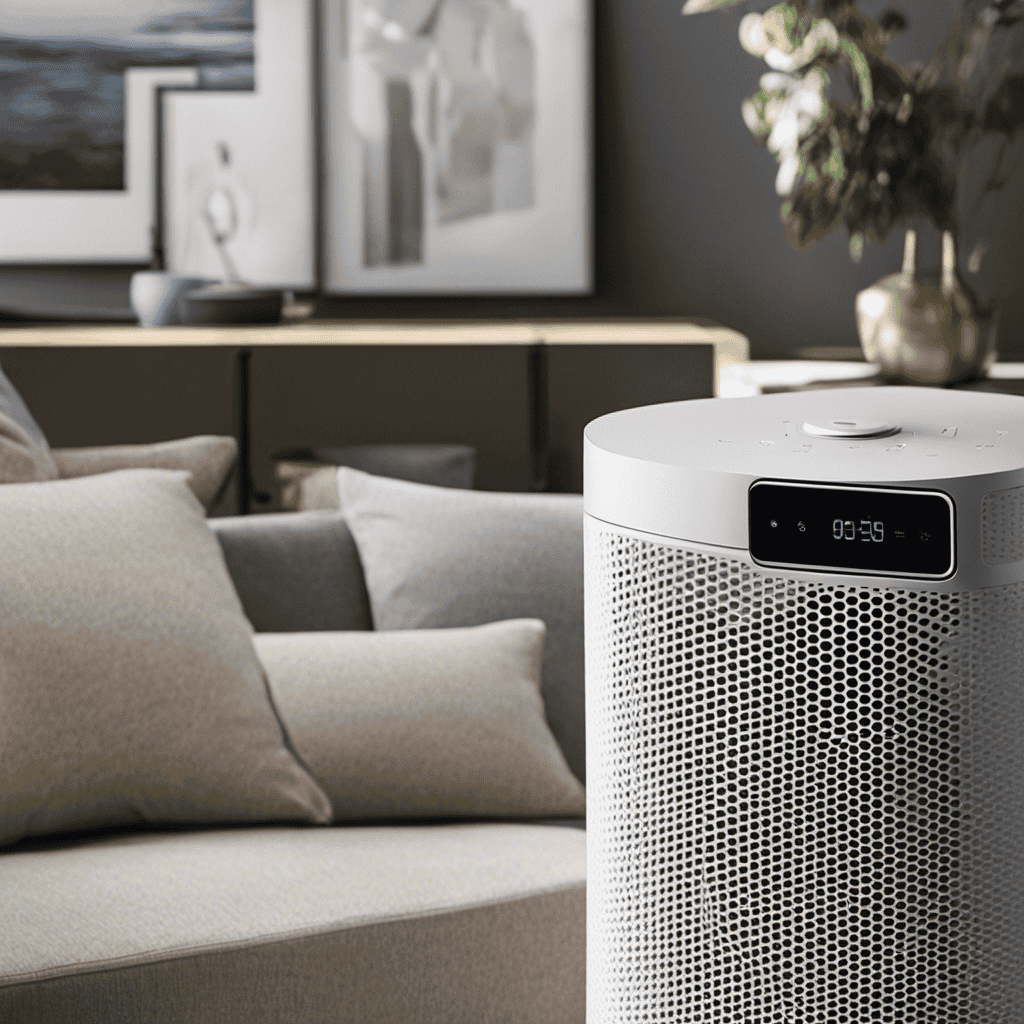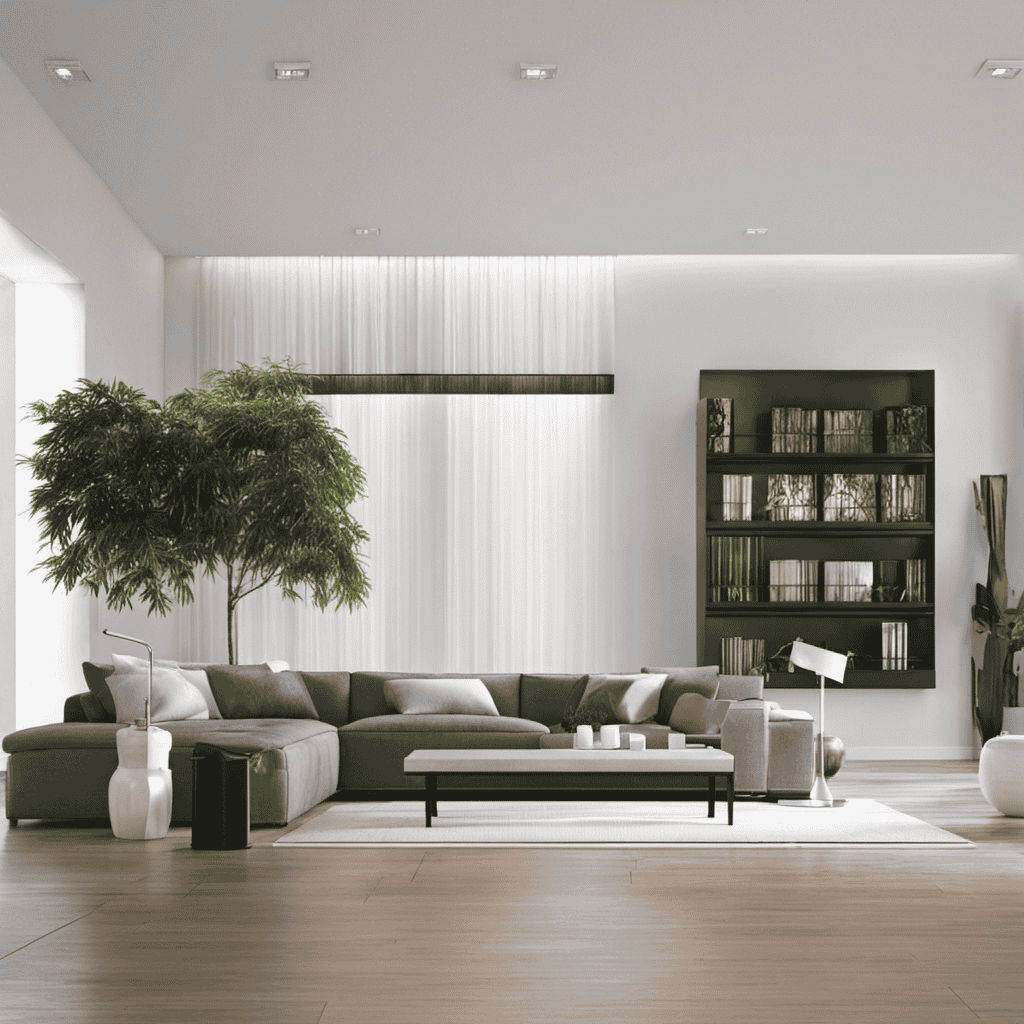When I’m not feeling well, I rely on my reliable air purifier. It acts as a defense against airborne germs and allergens, promoting a clean and healthy space for me to recuperate in.
In this article, we’ll explore how air purifiers can help alleviate cold symptoms and why they’re beneficial during illness. I’ll also provide tips on choosing the right air purifier and maximizing its benefits.
So, let’s dive in and discover the power of clean air when we’re sick.
Key Takeaways
- Using an air purifier when sick can help reduce the risk of respiratory infections.
- Air purifiers can alleviate symptoms of asthma and allergies, providing relief during illness.
- Regularly cleaning and maintaining the air purifier is important for optimal performance and maximum benefits.
- Air purifiers can create a healthier indoor environment, promoting faster recovery from illness.
How Air Purifiers Can Help Alleviate Cold Symptoms
If you’re feeling under the weather, using an air purifier can help you alleviate cold symptoms. When choosing an air purifier, it’s important to consider a few factors.
Look for one that has a high-efficiency particulate air (HEPA) filter, as this type of filter can capture particles as small as 0.3 microns, including common cold viruses.
Additionally, consider the size of the room where you’ll be using the air purifier, as you’ll want to choose a model that can effectively clean the air in that space.
The benefits of clean air are numerous when you’re sick. A good air purifier can remove airborne germs, allergens, and pollutants, reducing the risk of further respiratory infections. It can also help relieve congestion and improve overall indoor air quality, making it easier for you to breathe and recover faster.
The Benefits of Using an Air Purifier When Sick
When you’re feeling under the weather, using an air purifier can provide you with numerous benefits.
Air purifiers are particularly helpful for respiratory infections and asthma relief. These devices work by removing allergens, pollutants, and other harmful particles from the air, creating a cleaner and healthier environment.
Research has shown that air purifiers can effectively filter out bacteria and viruses, reducing the risk of respiratory infections.
For individuals with asthma, air purifiers can help remove triggers such as dust mites, pet dander, and pollen, leading to improved breathing and reduced asthma symptoms.
Additionally, air purifiers can help eliminate odors and improve indoor air quality, ensuring a more comfortable and soothing environment when you’re feeling unwell.
Investing in an air purifier can be a worthwhile decision to promote quicker recovery and overall well-being.
Choosing the Right Air Purifier for Your Illness
To choose the right air purifier for your illness, you should consider factors such as the size of your room, the specific pollutants you want to target, and the noise level of the device.
-
Size of your room:
A smaller room may require a compact air purifier, while a larger room may need a more powerful one. Measure the square footage of your room to determine the appropriate purifier size. -
Specific pollutants you want to target:
If you suffer from allergies, look for an air purifier with a HEPA filter that can capture allergens such as pollen, dust mites, and pet dander. For asthma or respiratory issues, consider an air purifier with an activated carbon filter to remove odors and chemicals. -
Noise level of the device:
If you’re sensitive to noise, choose an air purifier with a low noise level, especially for use in bedrooms or offices.
Understanding the Role of Air Quality in Your Health
Clean air is essential for maintaining good health, as it can greatly impact our overall well-being. Pollution, on the other hand, can have detrimental effects on our health, leading to respiratory issues, allergies, and even more serious conditions.
However, air purifiers can help alleviate these concerns by effectively removing pollutants from the air, providing us with cleaner and healthier indoor environments.
Importance of Clean Air
Breathing clean air is essential for your health, especially when you’re sick. When the air is polluted, it can have detrimental effects on your respiratory system and overall well-being.
Using an air purifier can greatly benefit your health by removing harmful pollutants from the air. Here are three reasons why clean air is important:
-
Air pollution effects: Polluted air can contain harmful particles like dust, pollen, and chemicals that can worsen respiratory conditions, trigger allergies, and even lead to serious health issues.
-
Air purifier benefits: An air purifier helps remove these pollutants from the air, creating a cleaner and healthier environment for you to breathe in.
-
Improved healing: When you’re sick, clean air can aid in your recovery by reducing the risk of respiratory infections and providing a comfortable and soothing environment for healing.
Breathing clean air is crucial, not only when you’re sick but also for maintaining good health in general.
Health Effects of Pollution
Clean air is not only important for our overall well-being, but it also plays a crucial role in protecting our respiratory health. Exposure to polluted air can have serious health risks, particularly when it comes to respiratory diseases.
Pollutants in the air, such as fine particulate matter, can irritate the respiratory system and lead to the development or exacerbation of conditions like asthma, bronchitis, and even lung cancer. Additionally, air pollution has been linked to an increased risk of heart disease, stroke, and premature death.
These health effects highlight the importance of taking steps to improve the air quality in our indoor spaces. One effective solution is the use of air purifiers, which can help remove pollutants and improve the overall air quality, providing numerous benefits for our respiratory health.
Benefits of Air Purifiers
Using an air purifier can greatly improve the quality of the air we breathe, reducing the risk of respiratory diseases and promoting overall well-being. Here are some benefits and advantages of using an air purifier:
-
Removes airborne pollutants: Air purifiers can effectively remove common pollutants such as dust, pollen, pet dander, and mold spores from the air, helping to alleviate allergies and asthma symptoms.
-
Eliminates odors: Air purifiers equipped with activated carbon filters can eliminate unpleasant smells from cooking, pets, and cigarette smoke, creating a fresh and clean indoor environment.
-
Filters out harmful particles: High-efficiency particulate air (HEPA) filters in air purifiers can capture tiny particles as small as 0.3 microns, including bacteria and viruses, reducing the risk of respiratory infections.
By using an air purifier, we can enjoy cleaner and healthier air in our homes.
Now, let’s explore some tips for using an air purifier to relieve respiratory issues.
Tips for Using an Air Purifier to Relieve Respiratory Issues
When it comes to using an air purifier to relieve respiratory issues, there are a few key points to keep in mind.
First, understanding the different allergen removal techniques can help you choose the right purifier for your needs.
Second, regular filter maintenance and replacement is crucial for optimal performance and to ensure that allergens are effectively removed from the air.
Lastly, choosing the right model for your specific requirements, such as room size, air quality concerns, and budget, is essential for achieving the desired respiratory relief.
Allergen Removal Techniques
You’ll want to consider the different allergen removal techniques available in order to effectively reduce the presence of irritants in the air when you’re feeling sick. Here are some options to help you choose the right one:
-
Allergen Detection Technology:
-
Some air purifiers come equipped with allergen detection technology, which can detect and target specific allergens in the air.
-
These purifiers use sensors to identify allergens such as pollen, dust mites, and pet dander, and then adjust their filtration system accordingly.
-
This technology ensures that the air you breathe is free from the specific allergens that trigger your symptoms.
-
Air Purifier Maintenance:
-
Regular maintenance of your air purifier is essential to keep it functioning optimally.
-
Clean the filters regularly as instructed by the manufacturer to prevent clogging and maintain efficient allergen removal.
-
Additionally, consider replacing the filters when they become too dirty or damaged to ensure the best air quality.
By utilizing allergen detection technology and maintaining your air purifier properly, you can create a healthier environment for yourself.
Now let’s explore the importance of filter maintenance and replacement.
Filter Maintenance and Replacement
Regularly cleaning and replacing the filters in my air purifier is crucial for maintaining optimal performance and ensuring a healthy environment. Filter replacement is an important aspect of air purifier maintenance that many people overlook.
The filters in an air purifier are responsible for trapping and removing pollutants, allergens, and other harmful particles from the air we breathe. Over time, these filters can become clogged and less effective, which can compromise the performance of the air purifier.
By regularly cleaning and replacing the filters, I can prolong their lifespan and ensure that my air purifier continues to work efficiently. This not only helps to improve air quality, but also reduces the risk of respiratory issues and allergies.
Choosing the Right Model
To find the right model for you, consider factors such as room size, filtration technology, and noise level.
When it comes to air purifiers, there are several benefits to consider. First, air purification helps remove allergens and pollutants from the air, which can be especially beneficial for those with allergies or respiratory issues. Additionally, air purifiers can help eliminate unpleasant odors and improve the overall air quality in your home.
When choosing an air purifier, it’s important to consider the size of the room where it will be used. A larger room may require a more powerful purifier to effectively clean the air. The filtration technology is also crucial. Look for purifiers with HEPA filters, as they are proven to be highly efficient in removing particles from the air.
Lastly, consider the noise level of the purifier, especially if you plan to use it in a bedroom or office space.
Improving Indoor Air Quality for a Speedy Recovery
Improving indoor air quality can help speed up your recovery when you’re sick. One effective way to purify the air in your home is by using indoor plants. Not only do they add a touch of nature to your space, but they also act as natural air purifiers.
Plants such as snake plants, peace lilies, and spider plants are known for their ability to filter out harmful toxins and release oxygen into the air.
Another way to enhance the air quality is through the use of aromatherapy with air purifiers. Essential oils like eucalyptus, lavender, and tea tree have antimicrobial properties that can help kill germs and bacteria, promoting a healthier environment.
The Science Behind Air Purifiers and Their Effectiveness
When it comes to improving indoor air quality while recovering from an illness, air purifiers are often recommended. These devices use advanced technology to effectively remove pollutants from the air, helping to create a healthier environment.
The effectiveness of air purification depends on several factors:
-
Filtration system: High-quality air purifiers use HEPA (High-Efficiency Particulate Air) filters to capture particles as small as 0.3 microns, including dust, pollen, pet dander, and even some bacteria and viruses.
-
Air exchange rate: The number of times an air purifier can cycle the air in a room per hour affects its effectiveness. Higher air exchange rates ensure more thorough purification.
-
Coverage area: The size of the room the air purifier can effectively clean is an important consideration. Choosing a device that matches the room size is crucial for optimal results.
Understanding the science behind air purifiers and their effectiveness can help you make an informed decision when selecting the right device for your needs. Now, let’s explore the key features to look for in an air purifier for illness.
Key Features to Look for in an Air Purifier for Illness
If you’re feeling under the weather, consider an air purifier with a UV-C light feature to help combat illness-causing germs. Air purifiers are designed to remove pollutants and improve indoor air quality.
When selecting an air purifier for illness, there are key features to look for that can enhance its effectiveness. Firstly, a HEPA filter is essential as it can capture particles as small as 0.3 microns, including bacteria and viruses. Secondly, an activated carbon filter can help eliminate odors and harmful chemicals. Thirdly, an air purifier with a UV-C light feature can provide an additional layer of protection by destroying germs and pathogens.
Lastly, consider the Clean Air Delivery Rate (CADR) which measures the purifier’s ability to remove pollutants efficiently. By choosing an air purifier with these features, you can enjoy the benefits of cleaner, healthier air and potentially reduce the risk of illness.
Using an Air Purifier to Combat Allergies and Sinusitis
When it comes to finding relief from allergies, using an air purifier can be a game changer.
Not only does it help filter out allergens like pollen and dust mites, but it also helps to improve indoor air quality, reducing the risk of sinusitis.
Allergy Relief With Purifier
Using an air purifier can provide allergy relief.
When it comes to dealing with pet allergies, an air purifier can be a game-changer. It helps to filter out pet dander and other allergens from the air, making it easier to breathe and reducing allergy symptoms.
For those with asthma, an air purifier can also make a significant difference. It helps to remove airborne irritants like dust mites, pollen, and mold spores, which are common triggers for asthma attacks.
With an air purifier, you can create a cleaner and healthier indoor environment, especially if you have pets or suffer from asthma. It’s a convenient and effective way to find relief from your allergies and breathe easier.
Sinusitis Prevention and Purifier
After learning about how an air purifier can provide relief from allergies, I wanted to explore its benefits in preventing sinusitis.
Sinusitis is a condition characterized by inflammation of the sinuses, often caused by pollutants and allergens in the air. By using an air purifier, you can effectively remove these harmful particles, reducing the risk of sinusitis.
Air purifiers work by capturing and trapping airborne bacteria, viruses, and allergens, preventing them from entering your respiratory system. This helps to keep your sinuses clear and healthy. Additionally, some air purifiers are equipped with HEPA filters, which can remove even smaller particles like dust mites and pollen.
Benefits of Clean Air
One of the benefits of having clean air is that it helps to improve overall respiratory health. Breathing in clean air can have a positive impact on our lungs and overall well-being. Here are three ways clean air can benefit our respiratory health:
-
Reduced exposure to indoor air pollutants: Clean air reduces our exposure to harmful pollutants such as dust, pollen, mold, and pet dander that can trigger respiratory issues and allergies.
-
Improved lung function: Clean air allows our lungs to function optimally, promoting better breathing and oxygen absorption. This can reduce the risk of respiratory conditions like asthma and chronic obstructive pulmonary disease (COPD).
-
Enhanced immune system: Clean air helps to maintain a strong immune system, enabling our bodies to fight off respiratory infections and illnesses more effectively.
Maintaining good indoor air quality is crucial for our respiratory health, as it can significantly impact our overall well-being.
Creating a Healthy Environment With an Air Purifier
To create a healthy environment when you’re sick, you should consider using an air purifier. Air purifiers are highly effective in removing harmful pollutants from the air, creating a clean and fresh atmosphere in your home. They can help reduce the risk of respiratory infections and allergies by eliminating dust, pollen, pet dander, and mold spores.
Here is a table that compares the effectiveness of different types of air purifiers:
| Type of Air Purifier | Effectiveness |
|---|---|
| HEPA Filters | High |
| Activated Carbon | Moderate |
| Ionic Air Purifiers | Low |
While HEPA filters are considered the most effective, activated carbon filters and ionic air purifiers can also provide some level of purification.
How to Clean and Maintain Your Air Purifier for Optimal Performance
Make sure you regularly clean and maintain your air purifier for optimal performance by following these simple steps:
- Vacuum the exterior of the air purifier to remove dust and debris.
- Remove and clean the pre-filter, which captures larger particles like pet hair and dust.
- Wash or replace the HEPA filter, which traps smaller particles like allergens and pollutants.
- If the filter is washable, gently rinse it with water and let it dry completely before reinstalling.
- If the filter is not washable, replace it according to the manufacturer’s instructions.
- Clean the ionizer plates, if your air purifier has one, by wiping them with a damp cloth.
- Wipe down the exterior of the air purifier with a soft cloth and mild detergent.
Regularly cleaning and maintaining your air purifier will ensure that it continues to effectively remove airborne particles, providing you with cleaner and healthier air.
Maximizing the Benefits of an Air Purifier for Cold and Flu Season
If you’re looking to maximize the benefits of an air purifier during cold and flu season, it’s important to regularly clean and maintain it. Air purifiers can be a great tool for reducing the risk of illness by removing harmful particles and allergens from the air. For those with allergies, air purifiers can help alleviate symptoms by trapping and filtering out pollen, dust mites, and pet dander. Similarly, individuals with asthma can benefit from cleaner air by reducing triggers such as mold spores and smoke particles. To ensure your air purifier is working at its best, make sure to clean or replace the filters regularly and keep the unit free from dust and debris. By doing so, you can maximize the effectiveness of your air purifier and create a healthier living environment.
| Allergies | Asthma | |
|---|---|---|
| Pollen | Mold | |
| Dust mites | Pet dander | |
| Smoke particles |
Addressing Mold and Bacteria With an Air Purifier
Now that we’ve discussed how to maximize the benefits of an air purifier during cold and flu season, let’s turn our attention to another important aspect of air purification: addressing mold and bacteria.
Mold and bacteria can thrive in our homes and contribute to respiratory infections and asthma symptoms. Fortunately, an air purifier can help combat these issues. Here are three ways an air purifier can address mold and bacteria:
-
Mold spore filtration: Air purifiers with HEPA filters can capture and remove mold spores from the air, preventing them from spreading and causing respiratory issues.
-
Bacteria elimination: Some air purifiers are equipped with UV-C light technology, which kills bacteria and prevents them from multiplying.
-
Odor reduction: Air purifiers with activated carbon filters can help reduce unpleasant odors caused by mold and bacteria.
By using an air purifier, you can create a healthier indoor environment by preventing respiratory infections and reducing asthma symptoms.
Now, let’s explore the link between indoor air pollution and illness.
The Link Between Indoor Air Pollution and Illness
To understand the link between indoor air pollution and illness, you should be aware of the various pollutants that can negatively affect your health.
Indoor air quality plays a crucial role in maintaining respiratory health. Pollutants such as dust, pet dander, mold, and volatile organic compounds (VOCs) are commonly found in indoor environments and can contribute to respiratory issues.
Dust and pet dander can trigger allergies and asthma symptoms, while mold spores can cause respiratory infections and exacerbate existing conditions. VOCs, which are emitted by common household products, can irritate the respiratory system and lead to headaches, dizziness, and nausea.
It is essential to maintain good indoor air quality by keeping the living space clean, properly ventilated, and using air purifiers to filter out harmful pollutants. Regularly monitoring and improving indoor air quality can help prevent respiratory illnesses and promote overall well-being.
Enhancing Sleep and Rest With an Air Purifier
Improve your sleep and rest by using an air purifier. It helps remove allergens and pollutants from your indoor environment. When you have clean air to breathe, you can experience a range of benefits that contribute to better sleep and overall well-being.
Here are three ways an air purifier can enhance your sleep and rest:
-
Reducing Allergies: Air purifiers are designed to capture and eliminate allergens such as dust mites, pet dander, and pollen. By removing these irritants from the air, you can reduce the risk of allergies or asthma symptoms that can disrupt your sleep.
-
Enhancing Concentration: Poor air quality can lead to fatigue and difficulty concentrating. By removing harmful pollutants and toxins from the air, an air purifier can create a healthier environment that supports mental clarity and focus during the day, leading to better sleep at night.
-
Creating a Relaxing Atmosphere: Air purifiers often come with features like noise reduction and calming lights, creating a soothing ambiance in your bedroom. This can help you unwind and relax, promoting a more restful sleep.
Incorporating an air purifier into your sleep routine can significantly improve your sleep quality, reduce allergies, and enhance concentration.
Frequently Asked Questions
Can an Air Purifier Completely Eliminate Cold Symptoms?
An air purifier can be effective in reducing cold symptoms by eliminating viruses in the air. Research has shown that air purifiers can help improve indoor air quality and potentially alleviate symptoms, although they may not completely eliminate them.
Are There Any Specific Air Purifier Models That Are Recommended for Different Illnesses?
I’ve found that some recommended air purifier models offer great benefits for respiratory conditions. They can help alleviate symptoms, like coughing and congestion, by filtering out allergens and pollutants in the air.
How Does Air Quality Impact Our Overall Health?
Indoor air pollution can have hidden dangers in our homes. Poor air quality can have long-term effects on respiratory health. It is important to consider how air quality impacts our overall health.
Can Using an Air Purifier Help With Allergies and Sinusitis?
Using an air purifier for allergies and sinusitis can be beneficial. It helps remove allergens and airborne particles that trigger symptoms. Additionally, during flu season, an air purifier can help reduce the spread of viruses in the air.
Is It Necessary to Clean and Maintain an Air Purifier Regularly for Optimal Performance?
Regular maintenance is crucial for optimal air purifier performance. Dirty filters can hinder effectiveness, just as neglecting self-care compromises our well-being. Clean, maintain, and breathe in cleaner air for a healthier life.
Conclusion
In conclusion, using an air purifier when sick is like having a guardian angel by your side, fighting off the invisible enemies that make you feel miserable.
It’s a breath of fresh air, quite literally, as it helps alleviate cold symptoms and enhances your overall well-being.
With the right air purifier tailored to your illness, you can create a clean and healthy environment that promotes healing.
So, don’t underestimate the power of clean air – it’s like a soothing lullaby for your body, ensuring a peaceful and restful recovery.










